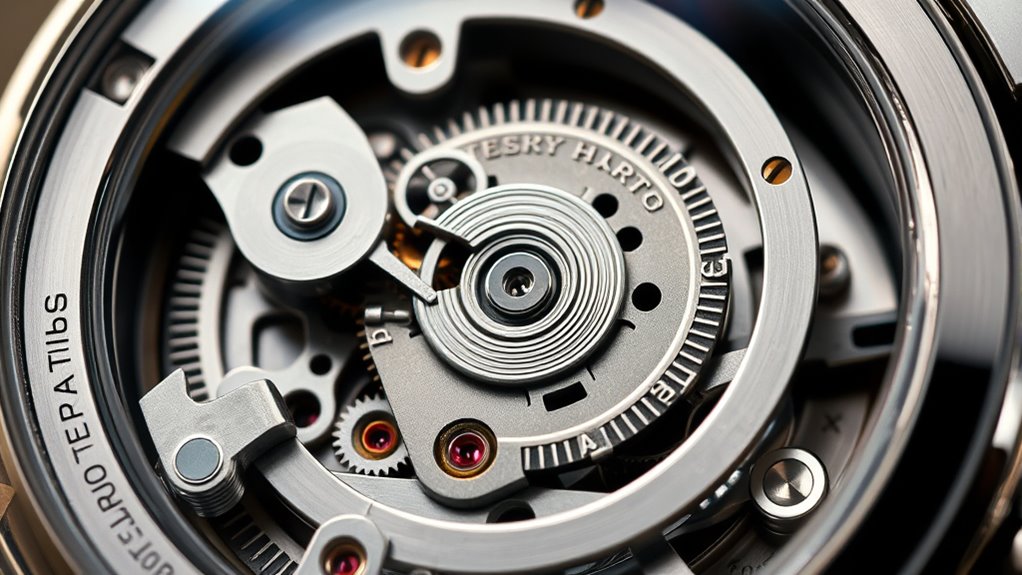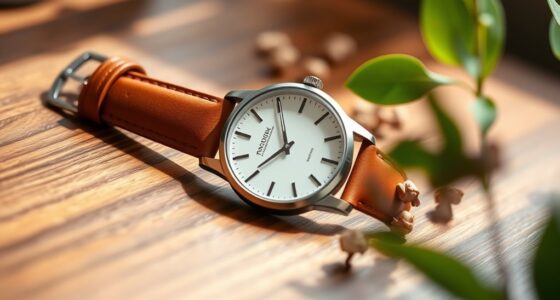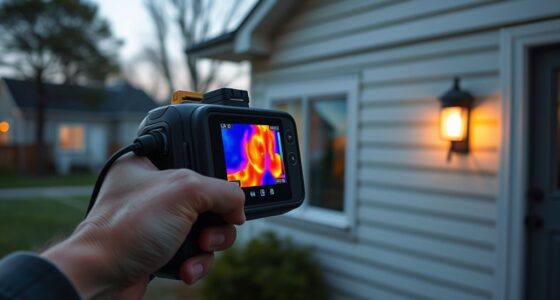Automatic watches get their power from a small, semi-circular rotor that swings with your wrist movements. As you wear the watch, this rotor moves freely and converts kinetic energy into mechanical energy, winding the mainspring inside. This stored energy powers the watch’s gears and hands. The more you wear your watch, the more it stays wound and accurate. To discover how this intricate system works, keep exploring what makes automatic watches tick.
Key Takeaways
- The rotor swings with wrist movement, converting kinetic energy into winding the mainspring.
- The mainspring stores the energy generated by the rotor’s motion.
- Regular wear keeps the mainspring wound, powering the watch’s movement continuously.
- Inactivity causes the mainspring to unwind, stopping the watch if not wound manually.
- The watch’s design optimizes energy transfer, ensuring consistent power without batteries.

Have you ever wondered how automatic watches keep ticking without batteries? The secret lies in their intricate winding mechanisms, which harness your natural movements to generate energy. Unlike quartz watches that rely on batteries, automatic watches are powered by a tiny, complex rotor inside the case. This rotor swings freely with your wrist’s motion, converting kinetic energy into mechanical energy. Every time you wear the watch, your wrist movement causes the rotor to spin, winding the mainspring—a tightly coiled spring that stores energy. This process is seamless and automatic, so you don’t need to do anything extra to keep it running. As long as you wear it regularly, the watch remains powered, ticking away precisely.
The winding mechanism is vital to the watch’s operation. It acts as the bridge between your movement and the watch’s internal power source. When you move your wrist, the rotor spins back and forth, transferring energy to wind the mainspring. This mainspring is what ultimately powers the watch’s gears and hands. If you don’t wear the watch for a while, the mainspring gradually unwinds, and the watch stops. That’s where the power reserve comes into play. The power reserve is the amount of time a watch can run after being fully wound without further movement. Most automatic watches have a power reserve ranging from 38 to 48 hours, though some high-end models can last even longer. When the mainspring unwinds, the watch slows down and eventually stops, which is why it’s vital to wear or wind it regularly to keep it accurate.
Understanding the winding mechanisms and power reserve helps you appreciate the craftsmanship behind automatic watches. They are designed to maximize energy efficiency and guarantee consistent performance. When you wear your watch daily, the natural movement keeps the mainspring wound, maintaining the power reserve and ensuring the watch continues to tick accurately. If you’ve been away for a few days, you can give your watch a gentle wind to supplement the winding process, boosting the power reserve and bringing it back to full operation. This combination of clever engineering and your movement creates a self-sustaining system that keeps your watch alive and precise without the need for batteries. It’s a marvel of mechanical ingenuity, where your everyday activity directly fuels the watch’s heartbeat.
Frequently Asked Questions
How Long Can an Automatic Watch Run Without Movement?
You can expect your automatic watch to run without movement for about 24 to 48 hours, depending on its power reserve. The winding mechanism stores energy as you wear it, but if you don’t move it regularly, it’ll stop once the power reserve depletes. To keep it running longer, you might need to manually wind it or wear it consistently, ensuring the winding mechanism recharges.
Do Automatic Watches Require Regular Servicing?
Yes, automatic watches do require regular servicing to keep them running accurately. Over time, dust, oil, and wear can affect the watch’s movement, impacting its winding efficiency and power reserve. Servicing ensures proper watch winding and lubrication, which helps maintain a healthy power reserve and prolongs the watch’s lifespan. Typically, it’s recommended to service your automatic watch every 3 to 5 years for ideal performance.
Can an Automatic Watch Be Manually Wound?
Yes, you can manually wind an automatic watch. By turning the crown clockwise, you engage in manual winding, which helps top off the power reserve when it’s running low. This process guarantees your watch keeps accurate time, especially if you haven’t worn it for a while. Regular manual winding can also help maintain the movement’s lubrication, prolonging the watch’s lifespan and ensuring it stays powered and precise.
What Factors Affect the Power Reserve of an Automatic Watch?
Your automatic watch’s power reserve depends on several factors, including the efficiency of its winding mechanism and how often you wear or wind it. A well-designed winding mechanism stores energy more effectively, extending the power reserve. Consistent movement keeps the watch wound, while inactivity shortens it. Keep in mind that environmental conditions and the watch’s age can also influence how long your automatic watch runs before needing a manual wind or wear.
Are Automatic Watches More Accurate Than Quartz Watches?
Think of automatic watches as delicate dancers and quartz watches as precise robots. Generally, quartz watches are more accurate, with a precision comparison showing they usually gain or lose just a few seconds per month. Automatic watches, however, depend on maintenance considerations and can vary slightly in accuracy. While they offer charm and craftsmanship, quartz watches consistently outperform in timekeeping precision, making them ideal for those valuing exactitude.
Conclusion
Now you see how automatic watches harness your motion, turning every step into energy. They dance with your daily actions, spinning with your wrist’s rhythm, winding with your movement’s flow. As your wrist moves, the mainspring tightens, storing power, ready to release it at just the right moment. With each gesture, you breathe life into the watch, creating a seamless cycle of energy and precision. Your motion becomes the heartbeat, fueling time itself.










